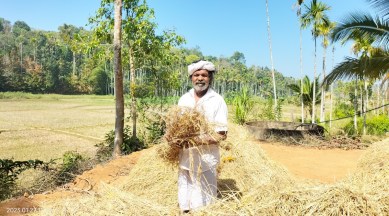Stay updated with the latest - Click here to follow us on Instagram
‘Don’t know what Padma award means’: Preserver of indigenous rice ploughs a lonely furrow
For two decades, Cheruvayal Raman – known locally as nellachan or the father of rice – has been collecting and sowing the indigenous rice varieties on his three-acre plot in Wayanad’s Kammana village.

It is another day for Cheruvayal Raman at his paddy field in the village of Kammana in Kerala. The 73-year-old tribal farmer, wearing a short thorthu (towel) and a shirt, his bare feet caked in mud, is busy arranging harvested rice stalks. Two days back, the government honoured him with the Padma Shri, one of the highest civilian awards in the country — but that has had little impact on his daily life.
Raman, known for meticulously conserving 55 indigenous rice varieties, was honoured in the category of agriculture. As he walks back from the paddy field, the Class 5 dropout takes a call on an old mobile handset. “I don’t know what the Padma award means. I don’t know whether it would bring in any benefits or I would get money. Do you know anything? There would be some protocol for me. Let them inform me about when I should go to Delhi,” he told a local man, who called to share the news.
The life of Raman, who belongs to the matrilineal tribe of Kurichiya in Wayanad district, is a study in itself for agricultural scientists from across the country. Known as nella achaan (rice father) in his locality, Raman has been toiling in the paddy field from the age of 10.
Known as “nellachan (father of rice)” in his locality, Raman – who belongs to the matrilineal tribe of Kurichiya in Wayanad – has been cultivating and preserving 55 rare varieties of rice seeds over the years.
“We are traditionally farmers and our extended family has 40 acres of land, but I own only three acres of paddy field. Until 2000, I had cultivated only four or five varieties of rice. Some agriculture enthusiasts wanted me to hand over those seeds for preservation. Then, I thought I would do it and started collecting seeds,” he says.
After every harvest season, Raman says, he used to visit paddy fields in Wayanad in search of different rice varieties for the last two decades. His rice bank slowly grew with every year and by 2016, Raman had collected 55 varieties. “Farmers, one after another, have been abandoning paddy cultivation. Some of these seeds would have become history, but for my initiative. Nobody wants to follow this unattractive, loss-making cultivation of rice,” he says.
The journey has not been easy. At the time, agri-scientists and governments were promoting high-yielding hybrid rice seeds, Raman was moving towards the past to collect the low-yielding seeds. “People, even family members, then dissuaded me. Because cultivating these seeds was a huge loss. They told me that I have become mad over rice. But I stuck to my decision and now everyone has acknowledged it,” he said.
Every year, he cultivates these 55 seeds. The three acres of land are divided into small segments in such a manner to ensure that every variety of seed is sown and cultivated. But a large portion of the land is used for growing one type of rice, meant for household consumption. “I don’t sell any seeds, but only happy to share them with farmers who want to cultivate. But they have to give back a portion of their harvest as seeds. Every year, we have to cultivate all the seeds, otherwise conservation would be impossible,” he says.
Raman said he is now scouting outside Kerala for new rice varieties. The Covid-19 lockdown and health issues have hampered his mission, but he has not abandoned the idea to fill the seed coffers with more varieties.
Cultivation has always been a lonely furrow for him. Every day, he reaches the paddy field at 6 am and toils till the evening, with a break at mid-day. These days, he has visitors in the form of food and agriculture enthusiasts who want to learn from the semi-literate tribal man. Often, he is invited to address seminars.
“Other family members have no time and there is shortage of labourers as all have gone for rural job guarantee schemes. I will toil until my end,” he says.
Although agriculture bodies and governments have recognized his contribution, Raman has not sought any assistance for conserving the seed bank. All seeds are kept in bamboo baskets inside his mud house, largely insulated from climate changes.
The ancestral hut itself is over a century old, thatched with straw and bamboo poles, the floors of its three rooms plastered with dung. There is no road leading to it, save a narrow walkway.
There, Raman lives with wife Geetha, 63, and two sons and their families. The eldest son, Ramesan, works with a co-operative bank, while the youngest, Rajesh, is an autorickshaw driver. The couple has two daughters, both married.
In 2018, Raman attended and presented his rice mission at an international symposium in Brazil. He had also won the National Plant Genome Saviour Award instituted by the Protection of Plant Varieties and Farmers Right Authority.
Now, he awaits the Padma awards ceremony in New Delhi. He has only one question: Can he wear a thorthu and shirt to the ceremony?